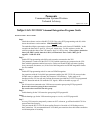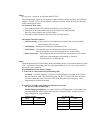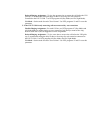
Step 8
At every user’s extension, go off-hook and dial 7192#.
This sets the proper Follow-on ID sequence so that forwarded calls go directly to the extension’s
mailbox. The KX-T123211D automatically sends the extension’s digits to the Voice Mail port
before connecting the caller.
For Follow-on ID to work:
• Ports connected to the TVS100 must be assigned as Voice Mail ports.
• Extensions must be forwarded to the first port of the Voice Mail (using the
Busy/No-Answer mode or the All Calls mode).
• The mailbox number should be the same as the extension number.
Interaction with other features:
• Call Forwarding—If the extension is forwarded to an extension that is also forwarded,
the forwarding will not work.
• Call Hunting—Hunting does not interfere with Follow-on ID.
• Call Transfer—Calls transferred to an extension with Follow-on ID enabled
and call forwarding set will be forwarded directly to the mailbox.
• Data Line Security—We recommend that all Voice Mail port extensions have this feature
enabled to avoid interruption of recording by Executive
Override tone or Call Waiting tone.
Step 9
Select the appropriate CO Line feature settings depending on how your customer plans to use the
VPS: A) to answer all incoming calls, B) as an operator backup, or C) to only answer calls not
answered by user extensions.
Recommended CO Line feature settings:
A. If the KX-TVS100 is answering all incoming calls:
CO Mode—Use PITS programs 51 and 52 to set this parameter. Program all lines DIL to
the first extension of the Voice Mail hunt group. The KX-T123211D will allow incoming
CO calls to hunt only if the CO lines are DIL to the first port of the hunt group. Lines
programmed as Normal do not hunt.
B. If the KX-TVS100 is only answering calls not answered by
the operator (Operator Backup):
Flexible Ringing Assignment—For each CO line, use PITS programs 47 (Day Mode) and
48 (Night Mode) to enable ringing at the operator’s extension (jack). Assign CO lines to
ring at VPS prots as suggested below.
2 Ports, 4 Lines 4 Ports, 8 Lines
Ports Lines Ports Lines
1 1, 3 1 1, 5
2 2, 4 2 2, 6
33, 7
44, 8





